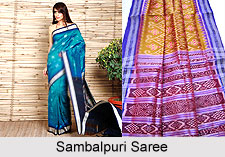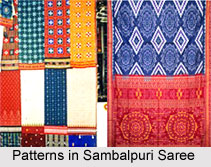 Sambalpuri Saree is a traditional hand-woven saree wherein the warp and the weft are "tie-dyed" before weaving. It is produced in the Bargarh, Sonepur, Sambalpur, Balangir and Boudh District of Odisha. Sambalpuri sarees are known for their incorporation of traditional motifs like shankha (shell), chakra (wheel), phula (flower), all of which have deep symbolism. Sometimes animal motifs are also used to decorate the borders and pallu. The highpoint of these sarees is the traditional craftsmanship of the "Bandhakala", the Tie-dye art reflected in their intricate weaves, also known as "Sambalpuri Ikkat". In this technique, the threads are first tie-dyed and later woven into a fabric, with the entire process taking many weeks. The Sambalpuri sari is made from fabric woven on a hand-loom and is popular throughout India. Varieties of the Sambalpuri sari include Sonepuri, Pasapali, Bomkai, Barpali and Bapta saris, which are in high demand.
Sambalpuri Saree is a traditional hand-woven saree wherein the warp and the weft are "tie-dyed" before weaving. It is produced in the Bargarh, Sonepur, Sambalpur, Balangir and Boudh District of Odisha. Sambalpuri sarees are known for their incorporation of traditional motifs like shankha (shell), chakra (wheel), phula (flower), all of which have deep symbolism. Sometimes animal motifs are also used to decorate the borders and pallu. The highpoint of these sarees is the traditional craftsmanship of the "Bandhakala", the Tie-dye art reflected in their intricate weaves, also known as "Sambalpuri Ikkat". In this technique, the threads are first tie-dyed and later woven into a fabric, with the entire process taking many weeks. The Sambalpuri sari is made from fabric woven on a hand-loom and is popular throughout India. Varieties of the Sambalpuri sari include Sonepuri, Pasapali, Bomkai, Barpali and Bapta saris, which are in high demand.
Fabric and Design of Sambalpuri Saree
Sambalpuri fabrics reflect an original style of craft known as Baandha. Traditionally, craftsmen created Baandhas with images of flora and fauna or with geometrical patterns. More recently, new types of Baandha depicting portrait, landscape and flower pods are being designed.
Baandha fabric is created using a tie-dye technique. The yarns are tied according to the desired patterns to prevent absorption of dyes, and then dyed. The yarns or set of yarns so produced is called "Baandha". The unique feature of this form of designing is that the designs are reflected almost identically on both side of the fabric. Once the fabric is dyed it can never be bleached in to other colour. The fabric may get thin and gradually damage but the colour still does not fade.
 The fabric is both silk and cotton. This versatile technique enables a craftsman to weave colourful designs, patterns and images into a fabric capable of inspiring a thought or conveying a message.
The fabric is both silk and cotton. This versatile technique enables a craftsman to weave colourful designs, patterns and images into a fabric capable of inspiring a thought or conveying a message.
Development of Sambalpuri Saree
Today, the Baandha fabric is popularly known by its geographical and cultural name Sambalpuri. Sri Radheshyam Meher, pioneer of Sambalpuri Saree had brought about a radical improvement in the skills of the craftsmen and the quality of the products. In 1926, Radheshyam designed the first handloom to weave textiles of 90 inches width. His dexterity in the Baandha art and his ability to motivate the weaving community in the region, to improve their skills by providing the necessary training and incentives enabled the creation of new designs that received international fame and recognition.
These sarees first became popular outside the state when the late Prime Minister Indira Gandhi started wearing them. In the 1980s and 1990s they became popular across India. To provide protection to the weavers practicing this art, the handloom silk sarees manufactured in Sambalpur and Berhampur in Odisha were included in the Government of India"s Geographical Indications registry.
Industry of Sambalpuri Saree
Sambalpuri Bastralaya Handloom Cooperative Society Ltd is the largest primary handloom co-operative society in the state and country as well. Odisha Saree Store started on the year 2013 with aim to promote handloom Sambalpuri, ikat, khandua, kotpad, siminoi sarees because this art is dying very fast. Besides saree one can get Sambalpuri curtains, bedsheets, dewan sets, sofa covers, towels, dress materials, Sambalpuri Salwar Kamiz, Kurti and Dhila.





















